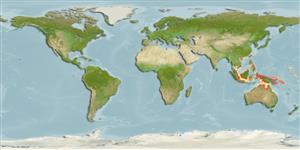Environment: milieu / climate zone / depth range / distribution range
Ecologia
marino; salmastro benthopelagico. Tropical
Western Pacific: northern Australia and southern New Guinea.
Size / Peso / Age
Maturity: Lm ? range ? - ? cm
Max length : 39.5 cm SL maschio/sesso non determinato; (Ref. 30691)
Spine dorsali (totale) : 1; Raggi anali molli: 22 - 25. Body coppery, golden brown, bronze or greyish pink. Dorsomedian head groove deep and elliptical posteriorly. Long barbels with maxillary pair 30 - 56% of SL; bases of chin barbels well separated and staggered. Gill rakers largely absent from hind aspect of the first 2 gill arches. Dorsal fin spine with a short filament at all ages (Ref. 38478).
Inhabits coastal waters and estuaries, river deltas and rivers within tidal influence. Feeds mainly on prawns and other crustaceans, fish, aquatic insects, plant material, and fish scales taken opportunistically (Ref. 38478).
Life cycle and mating behavior
Maturità | Riproduzione | Deposizione | Uova | Fecundity | Larve
Kailola, P.J., 1999. Ariidae (=Tachysuridae): sea catfishes (fork-tailed catfishes). p. 1827-1879. In K.E. Carpenter and V.H. Niem (eds.) FAO species identification guide for fishery purposes. The living marine resources of the Western Central Pacific. Vol. 3. Batoid fishes, chimaeras and bony fishes part 1 (Elopidae to Linophrynidae). FAO, Rome. (Ref. 38478)
IUCN Red List Status (Ref. 130435: Version 2024-1)
Threat to humans
Traumatogenic (Ref. 58010)
Human uses
Strumenti
Special reports
Download XML
Fonti Internet
Estimates based on models
Preferred temperature (Ref.
123201): 26.7 - 29, mean 28 °C (based on 298 cells).
Phylogenetic diversity index (Ref.
82804): PD
50 = 0.5156 [Uniqueness, from 0.5 = low to 2.0 = high].
Bayesian length-weight: a=0.00490 (0.00250 - 0.00959), b=3.13 (2.96 - 3.30), in cm total length, based on LWR estimates for this (Sub)family-body shape (Ref.
93245).
Trophic level (Ref.
69278): 3.7 ±0.4 se; based on diet studies.
Resilienza (Ref.
120179): Medio, tempo minimo di raddoppiamento della popolazione 1.4 - 4.4 anni (Preliminary K or Fecundity.).
Fishing Vulnerability (Ref.
59153): Moderate vulnerability (38 of 100).
